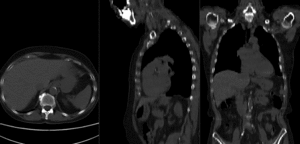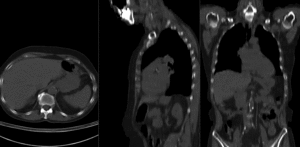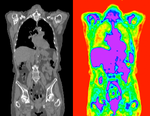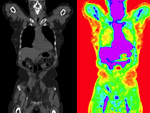Difference between revisions of "Documentation:Nightly:Registration:RegistrationLibrary:RegLib C20"
From Slicer Wiki
(→Input) |
|||
| Line 3: | Line 3: | ||
== Input == | == Input == | ||
{| style="color:#bbbbbb; " cellpadding="10" cellspacing="0" border="0" | {| style="color:#bbbbbb; " cellpadding="10" cellspacing="0" border="0" | ||
| − | |[[Image: | + | |[[Image:RegLib_C20_Thumb1.png|150px|left|this is the baseline PET/CT exam]] |
|[[Image:RegArrow_NonRigid.png|100px|left]] | |[[Image:RegArrow_NonRigid.png|100px|left]] | ||
| − | |[[Image: | + | |[[Image:RegLib_C20_Thumb2.png|150px|left|this is the follow-up exam, i.e. the moving image, to be aligned with the baseline]] |
|- | |- | ||
|fixed image/target<br>baseline PET/CT | |fixed image/target<br>baseline PET/CT | ||
| Line 11: | Line 11: | ||
|moving image<br>follow-up PET/CT | |moving image<br>follow-up PET/CT | ||
|} | |} | ||
| − | |||
== Modules used == | == Modules used == | ||
Revision as of 16:55, 28 August 2013
Home < Documentation:Nightly:Registration:RegistrationLibrary:RegLib C20Contents
Slicer Registration Library Case #20: Align PET/CT pair follow-up to baseline
Input
| fixed image/target baseline PET/CT |
moving image follow-up PET/CT |
Modules used
Download (from NAMIC MIDAS)
Keywords
PET/CT, full-body, intra-subject, nonrigid
Procedure
It is possible to perform both steps of affine and BSpline registration in a single pass within the General Registration (BRAINS) module, but to better show/judge progress we perform each separately and feed the results of one the the next step. Hence we first run an affine registration, then use that as starting point for a BSpline registration.
- 'Load & Center Volumes:
- the original unregistered PET/CT pair have very different image origins. When loaded into Slicer there is very little overlap between the two sets. We first re-center all the volumes to correct for this. Alternatively you can select the "Center Volume" option in the File dialog when loading the images.
- open to the Volumes module
- Active Volume: CT_1
- scroll down and click on the Center Volume button.
- repeat for "CT_2", "PET_1" and "PET_2" volumes
- open to the Volumes module
- Set the display properties:
- the CT and PET have very distinct colormaps. Slicer provides presets for both types
- open to the Volumes module
- Active Volume: CT_1
- Window/Level editor presets: click on the "CT-abdomen" button (3rd from the right).
- repeat for volume "CT_2"
- for "PET_1" and "PET_2" select the "PET" preset (3rd from the left)
- since zero in the PET colormap is red, we set a threshold to suppress this: from Threshold menu, select "Manual" and set the left/lower threshold to ~ 600. You can also drag the pop-up slider until most of the red background turns to black.
- Compute Affine Registration: open to the General Registration (BRAINS) module
- Input Images: Fixed Image Volume: CT_1
- Input Images: Moving Image Volume: CT_2
- Output Settings:
- Slicer Linear Transform: (create new transform, rename to: "Xf1_Affine")
- Output Image Volume: none (we need no resampled volume at this stage, only the transform)
- Initialization: none
- Initialize Transform Mode: switch to Off (there is sufficient overlap)
- Registration Phases: 'check Rigid, Rigid+Scale and Affine only
- Main Parameters:
- increase Number Of Samples to at least 200,000
- Leave all other settings at default
- click: Apply; runtime < 2 min.
- check the result
- Place "CT_1" in the background and "CT_2" in the foreground
- switch to the Data module, verify that the "CT_2" node is inside the newly created "Xf1_Affine" node. The registration module should do that automatically for you. You may see a small "+" next to the "Xf1_Affine" node, click on it to reveal the contents.
- fade between background and foreground to judge the alignment.
- Compute BSpline Registration: return to the General Registration (BRAINS) module
- Input Images: Fixed Image Volume: CT_1
- Input Images: Moving Image Volume: CT_2
- Output Settings:
- Slicer BSpline Transform: Create and rename new. Rename to "Xf2_BSpline"
- Slicer Linear Transform: set to none
- Output Image Volume: Create and rename new. Rename to "CT_2_Xf2" (we need a resampled volume to visualize the result. Nonrigid transforms cannot be visualized on the fly)
- Initialization: for the Initialization transform select the "Xf1_Affine" transform created above.
- Initialize Transform Mode: switch to Off
- Registration Phases: uncheck Rigid+Scale and Affine and select BSpline only
- Main Parameters:
- increase Number Of Samples to 300,000
- set B-Spline Grid Size to 11,11,7
- Leave all other settings at default
- click: Apply; runtime for this will be more than 1 minute, depending on CPU.
- check the result
- Place "CT_1" in the background and "CT_2_Xf2" in the foreground
- fade between background and foreground to judge the alignment.
- Apply transform to PET
Registration Results
 |before registration (click to enlarge) |before registration (click to enlarge)
|
 |after affine registration (click to enlarge) |after affine registration (click to enlarge)
|
 |BSpline deformation grid (click to enlarge) |BSpline deformation grid (click to enlarge)
|


